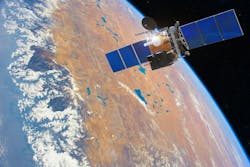Merida announces it is devloping perovskite solar cells for LEO satellites
TAMPA, Fla., - Merida Aerospace, a Tampa-based aerospace company, is developing perovskite solar cells tailored for space applications, with a specific emphasis on enhancing performance and economy for low Earth orbit (LEO) satellites.
Solar panels are a common energy source for LEO satellites, harnessing sunlight during orbital solar exposure for continuous operation. These panels enhance efficiency by reducing the reliance on numerous batteries, enabling autonomous function during intermittent sunlight access in low earth orbit.
Gallium arsenide solar panels, with efficiencies of around 30%, have been the standard in space solar energy. The unique semiconductor properties of gallium arsenide make it suitable for space applications. Despite their performance, these panels face challenges due to higher manufacturing costs, mainly due to gallium's scarcity and the complex manufacturing process. These constraints have prompted the exploration of alternative materials and manufacturing processes to make high-efficiency solar cells more economically viable.
Perovskite solar cells emerge as a promising alternative, offering advantages over gallium arsenide. Perovskite cells provide cost-effectiveness through simplified and economical manufacturing processes. Their flexibility makes them suitable for diverse applications, from lightweight to bendable solar panels. While gallium arsenide has been synonymous with high efficiency, ongoing research indicates that perovskite cells are rapidly closing the efficiency gap, displaying potential comparable or even higher efficiency levels.
Merida Aerospace's research engineer, Andrea Marquez, oversees the developmental project. Marquez notes, "Perovskite solar cells have demonstrated remarkable resilience to high-energy radiation in space conditions, thanks to a self-healing effect. Furthermore, the arrangement of perovskite crystals is influenced by space temperatures, enhancing their light absorption capabilities."
Perovskite solar cells represent a potential breakthrough due to their efficiency and unique optical properties. Their crystalline structure allows optimal light absorption, rivaling or exceeding traditional silicon-based solar cells. The cost-effective processing of perovskite makes it attractive for lightweight, flexible, and adaptable solar panels, potentially revolutionizing the solar energy landscape.
National Aeonautics and Space Administration (NASA) research engineer Dr. Lyndsey McMillon-Brown recently celebrated the success of a spaceflight demonstration testing perovskite durability on the International Space Station. After a 10-month exposure, the perovskite film displayed resilience and unexpected restorative properties, challenging previous doubts and opening exciting possibilities for perovskite in space exploration.
